SUZUKI GRAND VITARA 1987 Service Repair Manual
Manufacturer: SUZUKI, Model Year: 1987, Model line: GRAND VITARA, Model: SUZUKI GRAND VITARA 1987Pages: 962, PDF Size: 27.87 MB
Page 411 of 962
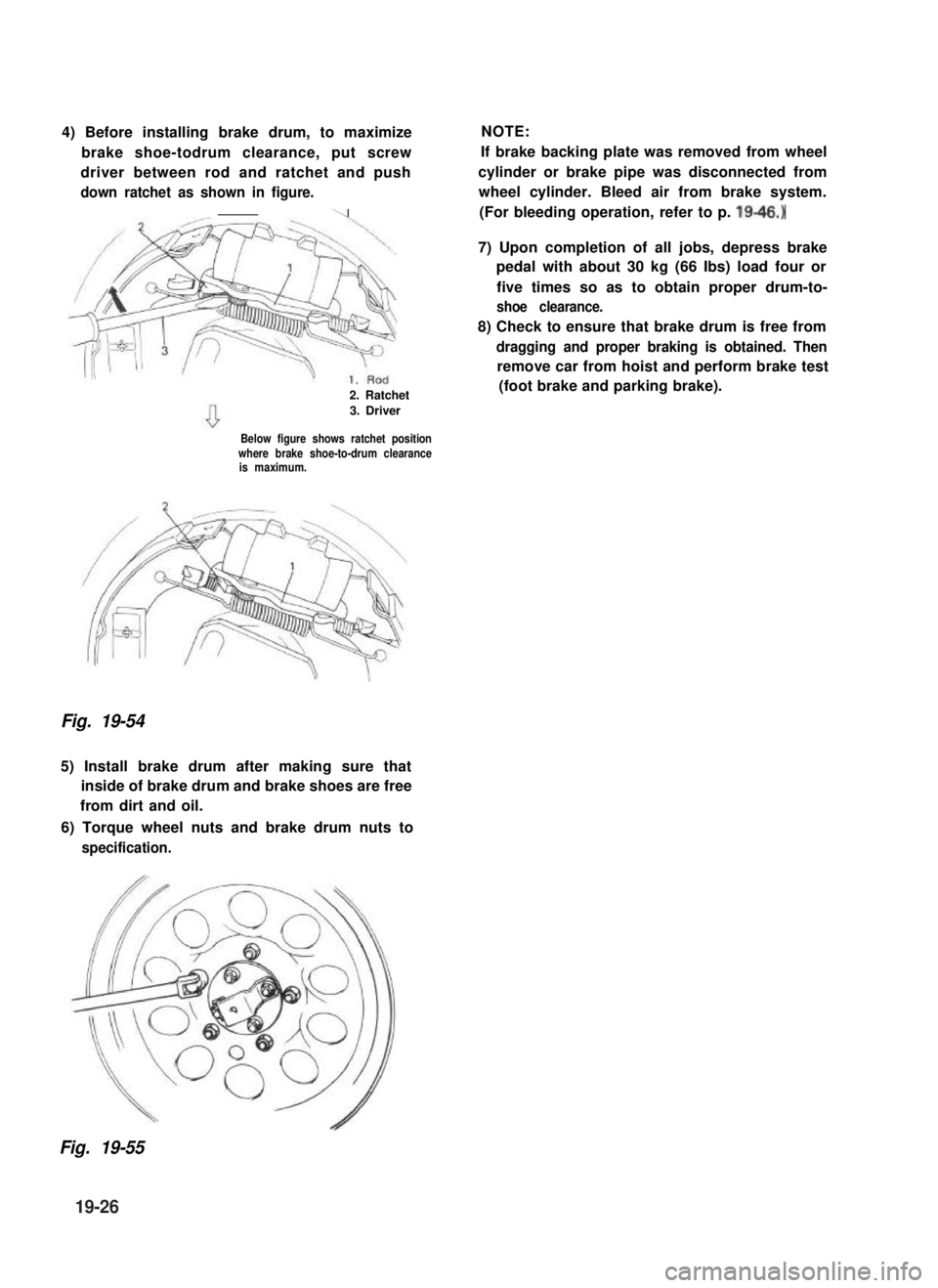
4) Before installing brake drum, to maximize
brake shoe-todrum clearance, put screw
driver between rod and ratchet and push
down ratchet as shown in figure.
\
2. Ratchet
3. Driver
Below figure shows ratchet positionwhere brake shoe-to-drum clearanceis maximum.
Fig. 19-54
5) Install brake drum after making sure that
inside of brake drum and brake shoes are free
from dirt and oil.
6) Torque wheel nuts and brake drum nuts to
specification.
NOTE:
If brake backing plate was removed from wheel
cylinder or brake pipe was disconnected from
wheel cylinder. Bleed air from brake system.
(For bleeding operation, refer to p. 19-46.)
7) Upon completion of all jobs, depress brake
pedal with about 30 kg (66 Ibs) load four or
five times so as to obtain proper drum-to-
shoe clearance.
8) Check to ensure that brake drum is free from
dragging and proper braking is obtained. Then
remove car from hoist and perform brake test
(foot brake and parking brake).
Fig. 19-55
19-26
Page 412 of 962
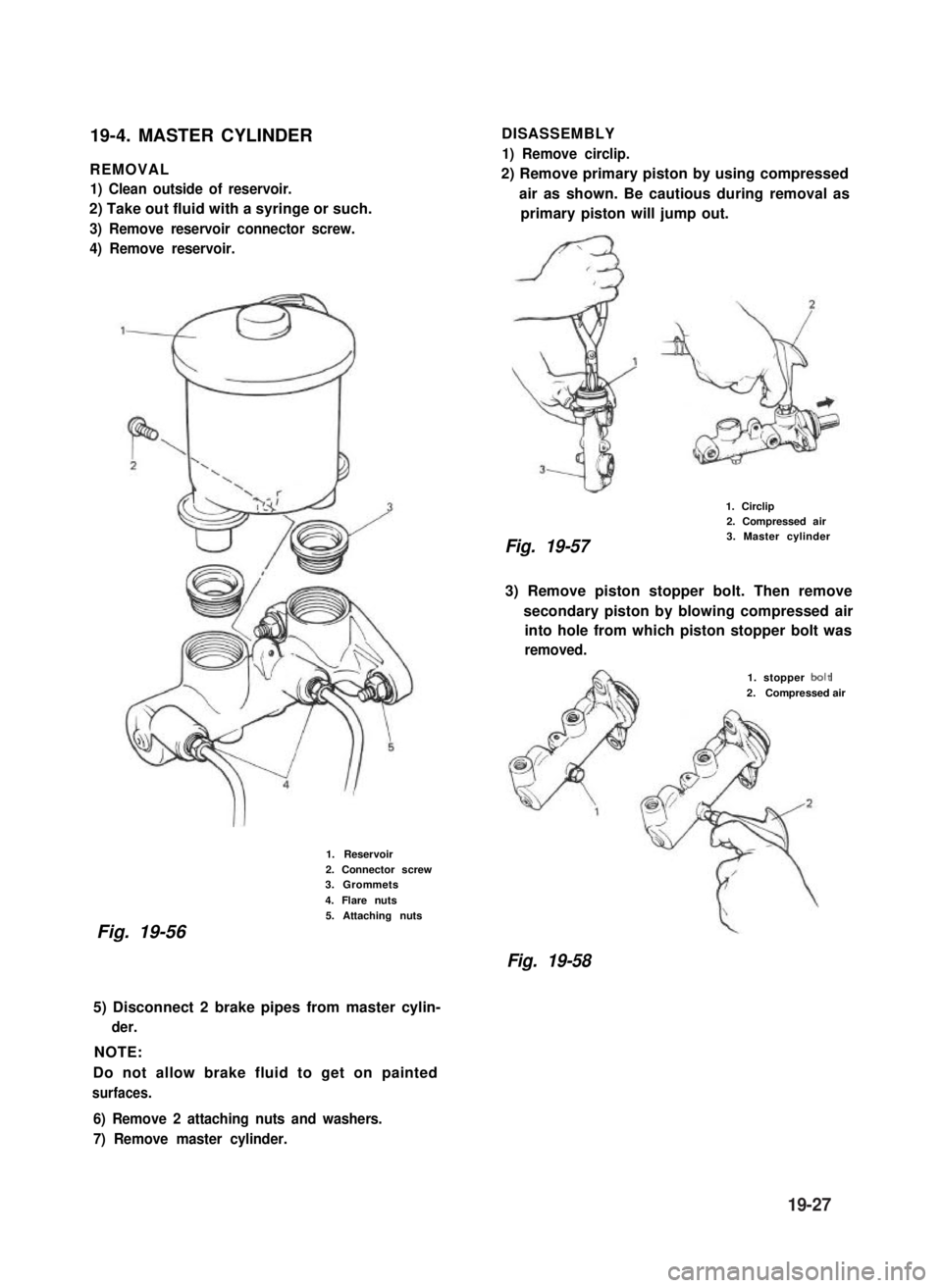
19-4. MASTER CYLINDER
REMOVAL
1) Clean outside of reservoir.
2) Take out fluid with a syringe or such.
3) Remove reservoir connector screw.
4) Remove reservoir.
1. Reservoir
2. Connector screw3. Grommets
4. Flare nuts
5. Attaching nuts
Fig. 19-56
5) Disconnect 2 brake pipes from master cylin-
der.
NOTE:
Do not allow brake fluid to get on painted
surfaces.
6) Remove 2 attaching nuts and washers.
7) Remove master cylinder.
DISASSEMBLY
1) Remove circlip.
2) Remove primary piston by using compressed
air as shown. Be cautious during removal as
primary piston will jump out.
Fig. 19-57
2. Compressed air3. Master cylinder
3) Remove piston stopper bolt. Then remove
secondary piston by blowing compressed air
into hole from which piston stopper bolt was
removed.
1. stopper bolt
2.Compressed air
Fig. 19-58
1. Circlip
19-27
Page 413 of 962
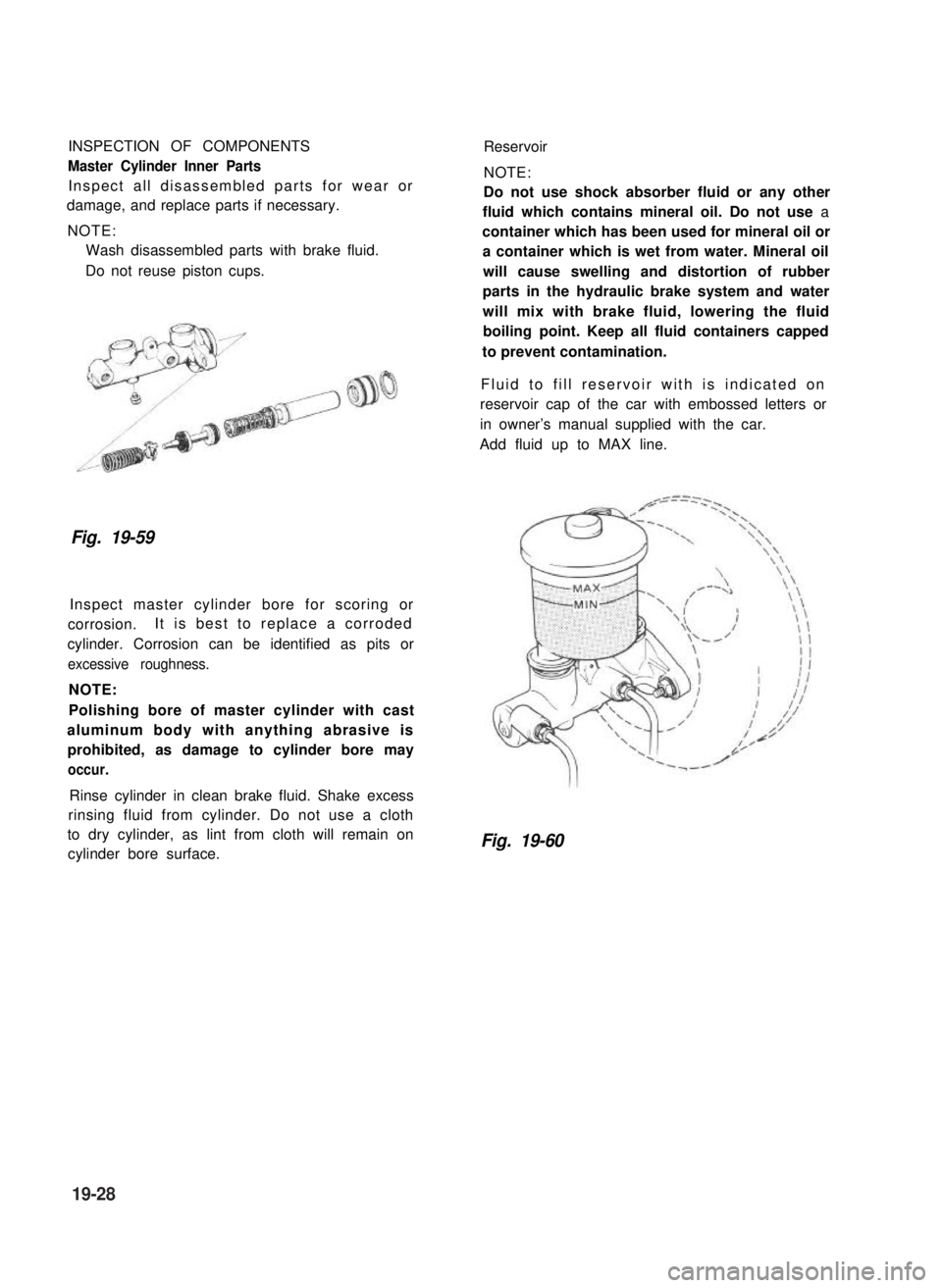
INSPECTION OF COMPONENTS
Master Cylinder Inner Parts
Inspect all disassembled parts for wear or
damage, and replace parts if necessary.
NOTE:
Wash disassembled parts with brake fluid.
Do not reuse piston cups.
Reservoir
NOTE:
Do not use shock absorber fluid or any other
fluid which contains mineral oil. Do not use a
container which has been used for mineral oil or
a container which is wet from water. Mineral oil
will cause swelling and distortion of rubber
parts in the hydraulic brake system and water
will mix with brake fluid, lowering the fluid
boiling point. Keep all fluid containers capped
to prevent contamination.
Fluid to fill reservoir with is indicated on
reservoir cap of the car with embossed letters or
in owner’s manual supplied with the car.
Add fluid up to MAX line.
Fig. 19-59
Inspect master cylinder bore for scoring or
corrosion.It is best to replace a corroded
cylinder. Corrosion can be identified as pits or
excessive roughness.
NOTE:
Polishing bore of master cylinder with cast
aluminum body with anything abrasive is
prohibited, as damage to cylinder bore may
occur.
Rinse cylinder in clean brake fluid. Shake excess
rinsing fluid from cylinder. Do not use a cloth
to dry cylinder, as lint from cloth will remain on
cylinder bore surface.Fig. 19-60
19-28
Page 414 of 962
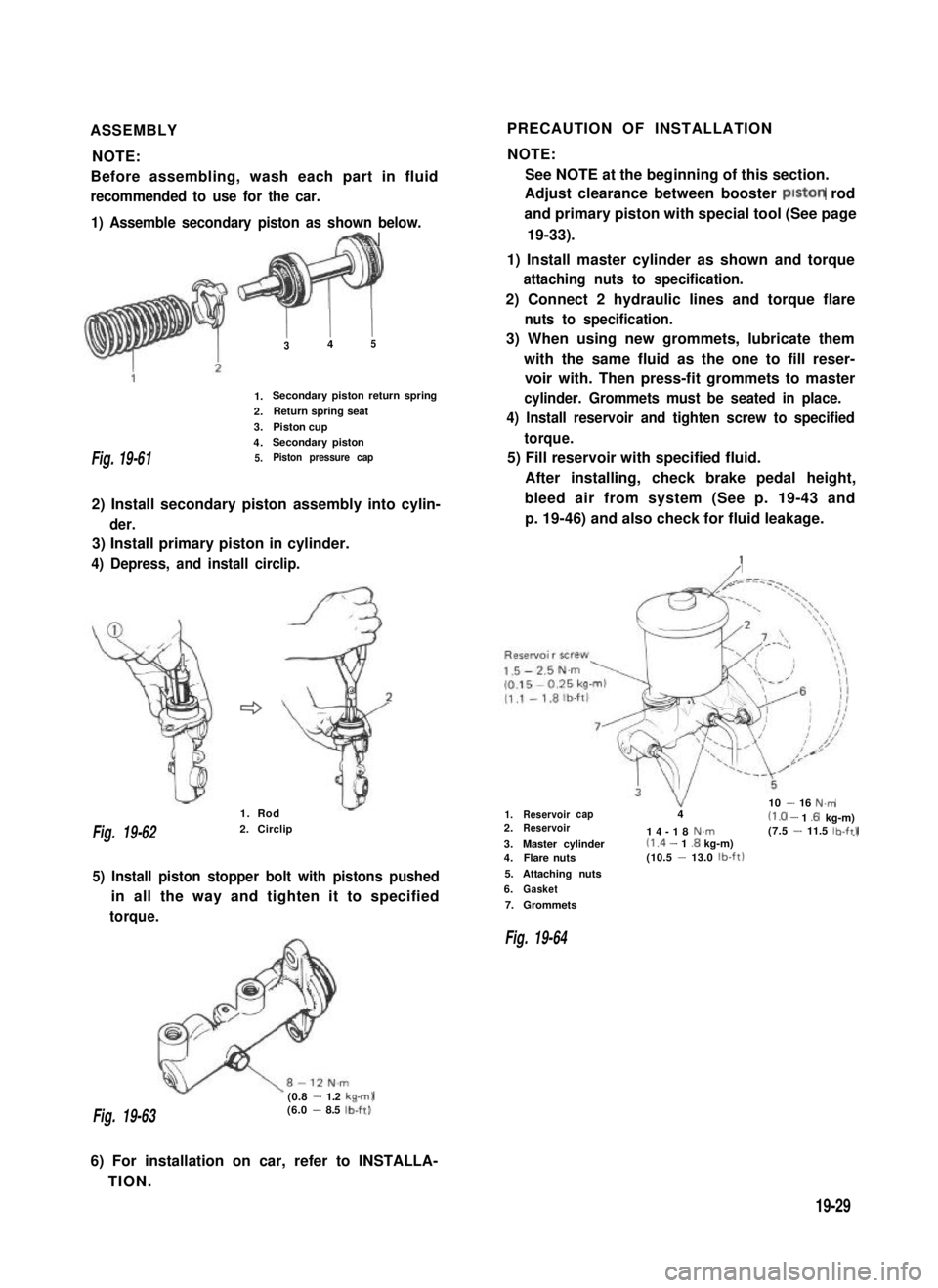
ASSEMBLYPRECAUTION OF INSTALLATION
NOTE:NOTE:
Before assembling, wash each part in fluidSee NOTE at the beginning of this section.
recommended to use for the car.Adjust clearance between booster piston rod
1) Assemble secondary piston as shown below.
FBh
and primary piston with special tool (See page
19-33).
Fig. 19-61
1) Install master cylinder as shown and torque
attaching nuts to specification.
2) Connect 2 hydraulic lines and torque flare
1.
2.
3.
4.
5.
I I345
Secondary piston return spring
Return spring seat
Piston cupSecondary piston
Piston pressure cap
2) Install secondary piston assembly into cylin-
der.
3) Install primary piston in cylinder.
4) Depress, and install circlip.
nuts to specification.
3) When using new grommets, lubricate them
with the same fluid as the one to fill reser-
voir with. Then press-fit grommets to master
cylinder. Grommets must be seated in place.
4) Install reservoir and tighten screw to specified
torque.
5) Fill reservoir with specified fluid.
After installing, check brake pedal height,
bleed air from system (See p. 19-43 and
p. 19-46) and also check for fluid leakage.
:
Fig. 19-622. Circlip
1. Rod
5) Install piston stopper bolt with pistons pushed
in all the way and tighten it to specified
torque.
(0.8 - 1.2 kam)
1.Reservoir10 - 16 N.mcap42.Reservoir(1 .O - 1 .6 kg-m)14-18N.m(7.5 - 11.5 lb-ftl--I3.Master cylinder(1 .4 - 1.8 kg-m)4.Flare nuts(10.5 -13.0 lb-ft)
5.Attaching nuts
6.Gasket
7.Grommets
Fig. 19-64
Fig. 19-63(6.0 - 8.5 lb-ft).
6) For installation on car, refer to INSTALLA-
TION.
19-29
Page 415 of 962
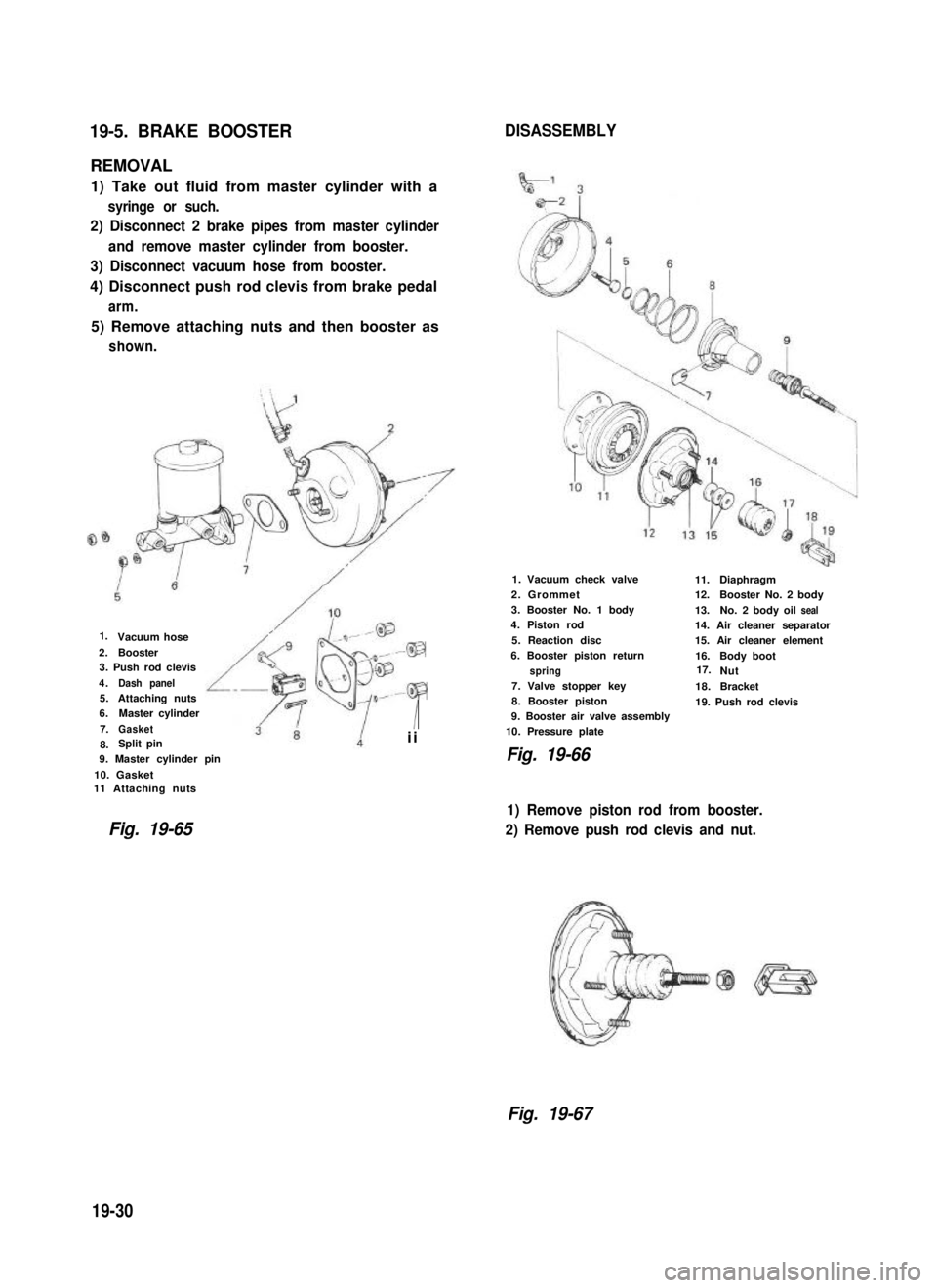
19-5. BRAKE BOOSTERDISASSEMBLY
REMOVAL
1) Take out fluid from master cylinder with a
syringe or such.
2) Disconnect 2 brake pipes from master cylinder
and remove master cylinder from booster.
3) Disconnect vacuum hose from booster.
4) Disconnect push rod clevis from brake pedal
arm.
5) Remove attaching nuts and then booster as
shown.
Vacuum hose
2.Booster3. Push rod clevis
4.Dash panel5.Attaching nuts6.Master cylinder
7.Gasket
8. Split pin
9. Master cylinder pin
10. Gasket11 Attaching nuts
Fig. 19-65
49
-@P
Iii
1. Vacuum check valve
2. Grommet3. Booster No. 1 body4. Piston rod
5. Reaction disc6. Booster piston return
spring7. Valve stopper key8. Booster piston9. Booster air valve assembly10. Pressure plate
Fig. 19-66
11.Diaphragm12.Booster No. 2body
13.No. 2 body oilseal14. Air cleaner separator15. Air cleaner element
16.Body bootNut
18.Bracket
19. Push rod clevis
1) Remove piston rod from booster.
2) Remove push rod clevis and nut.
Fig. 19-67
19-30
1.
17.
Page 416 of 962
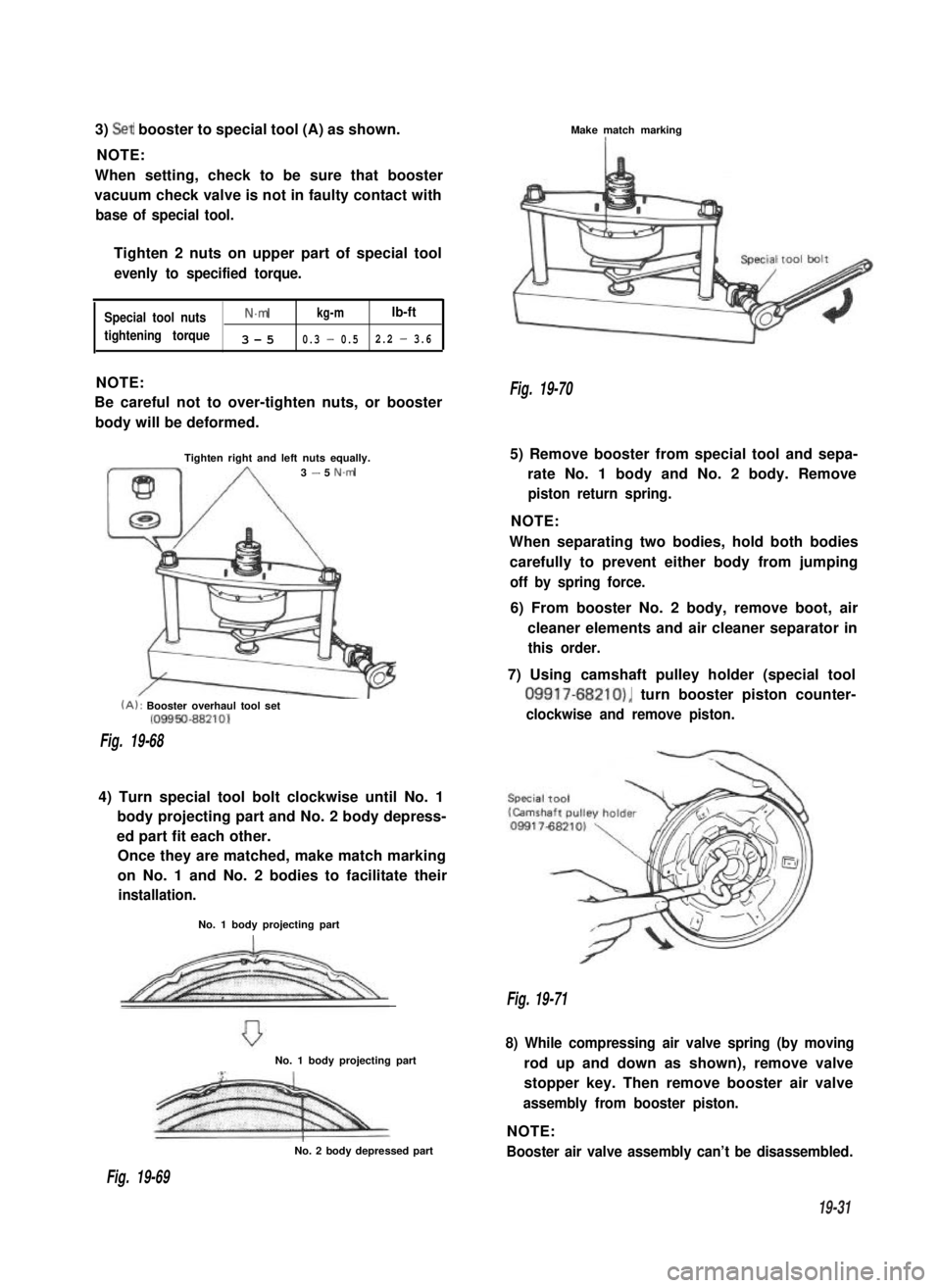
3) Set booster to special tool (A) as shown.
NOTE:
When setting, check to be sure that booster
vacuum check valve is not in faulty contact with
base of special tool.
Tighten 2 nuts on upper part of special tool
evenly to specified torque.
Special tool nutsN.mkg-mlb-ft
tightening torque3-50.3 - 0.52.2 - 3.6
NOTE:
Be careful not to over-tighten nuts, or booster
body will be deformed.
Tighten right and left nuts equally.3 - 5 N.m
(A): Booster overhaul tool set(09950-88210)
Fig. 19-68
4) Turn special tool bolt clockwise until No. 1
body projecting part and No. 2 body depress-
ed part fit each other.
Once they are matched, make match marking
on No. 1 and No. 2 bodies to facilitate their
installation.
No. 1 body projecting part
No. 1 body projecting part
No. 2 body depressed part
Make match markingI
Fig. 19-70
5) Remove booster from special tool and sepa-
rate No. 1 body and No. 2 body. Remove
piston return spring.
NOTE:
When separating two bodies, hold both bodies
carefully to prevent either body from jumping
off by spring force.
6) From booster No. 2 body, remove boot, air
cleaner elements and air cleaner separator in
this order.
7) Using camshaft pulley holder (special tool
09917-68210), turn booster piston counter-
clockwise and remove piston.
Fig. 19-71
8) While compressing air valve spring (by moving
rod up and down as shown), remove valve
stopper key. Then remove booster air valve
assembly from booster piston.
NOTE:
Booster air valve assembly can’t be disassembled.
Fig. 19-69
19-31
Page 417 of 962
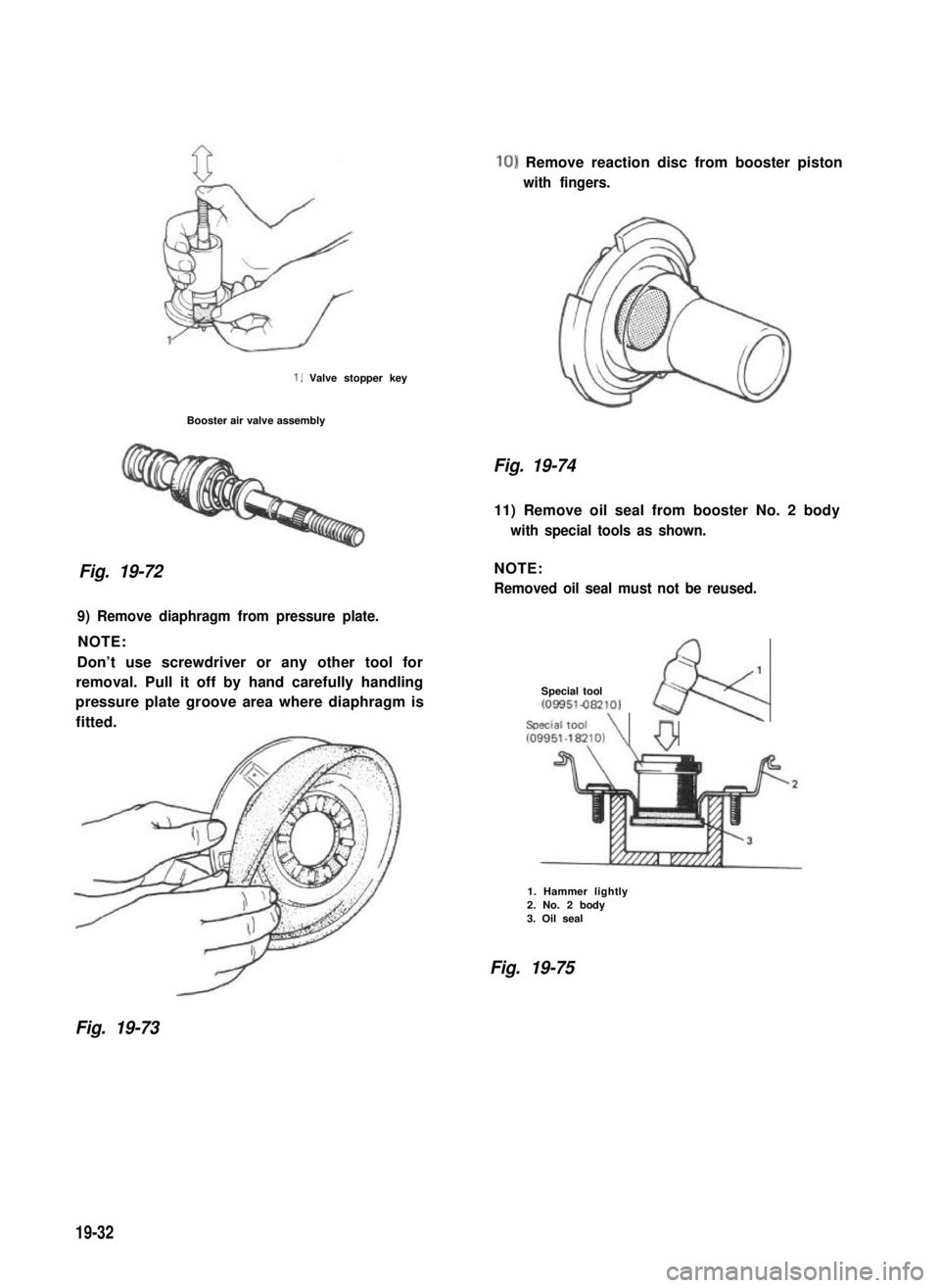
1. Valve stopper key
Booster air valve assembly
Fig. 19-72
10) Remove reaction disc from booster piston
with fingers.
Fig. 19-74
11) Remove oil seal from booster No. 2 body
with special tools as shown.
NOTE:
Removed oil seal must not be reused.
;1
Special tool~09951-082101
Special toolk
109951~W~lO,\ 0
9) Remove diaphragm from pressure plate.
NOTE:
Don’t use screwdriver or any other tool for
removal. Pull it off by hand carefully handling
pressure plate groove area where diaphragm is
fitted.
1. Hammer lightly2. No. 2 body3. Oil seal
Fig. 19-75
Fig. 19-73
19-32
Page 418 of 962
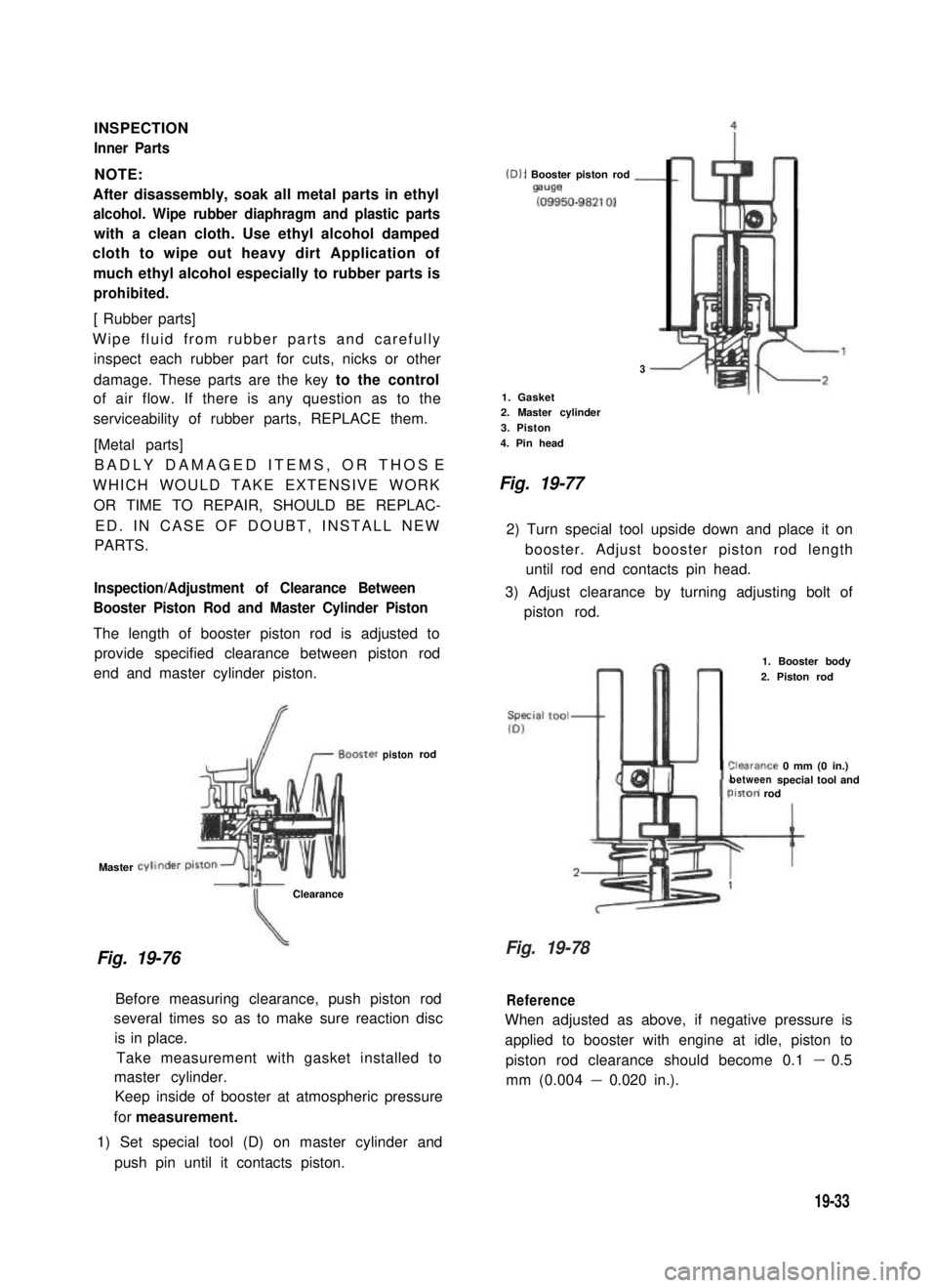
INSPECTION
Inner Parts
NOTE:
After disassembly, soak all metal parts in ethyl
alcohol. Wipe rubber diaphragm and plastic parts
with a clean cloth. Use ethyl alcohol damped
cloth to wipe out heavy dirt Application of
much ethyl alcohol especially to rubber parts is
prohibited.
[ Rubber parts]
Wipe fluid from rubber parts and carefully
inspect each rubber part for cuts, nicks or other
damage. These parts are the key to the control
of air flow. If there is any question as to the
serviceability of rubber parts, REPLACE them.
[Metal parts]
BADLY DAMAGED ITEMS, OR THOSE
WHICH WOULD TAKE EXTENSIVE WORK
OR TIME TO REPAIR, SHOULD BE REPLAC-
ED. IN CASE OF DOUBT, INSTALL NEW
PARTS.
Inspection/Adjustment of Clearance Between
Booster Piston Rod and Master Cylinder Piston
The length of booster piston rod is adjusted to
provide specified clearance between piston rod
end and master cylinder piston.
Master
Fig. 19-76
Clearance
(D): Booster piston rod -mwe
(09950-98210)
3
1. Gasket2. Master cylinder
3. Piston
4. Pin head
Fig. 19-77
2) Turn special tool upside down and place it on
booster. Adjust booster piston rod length
until rod end contacts pin head.
3) Adjust clearance by turning adjusting bolt of
piston rod.
pistonrod
Before measuring clearance, push piston rod
several times so as to make sure reaction disc
is in place.
Take measurement with gasket installed to
master cylinder.
Keep inside of booster at atmospheric pressure
for measurement.
1) Set special tool (D) on master cylinder and
push pin until it contacts piston.
1. Booster body
2. Piston rod
%arance 0 mm (0 in.)betweenspecial tool andiston rod
Reference
When adjusted as above, if negative pressure is
applied to booster with engine at idle, piston to
piston rod clearance should become 0.1 - 0.5
mm (0.004 - 0.020 in.).
19-33
Fig. 19-78
Page 419 of 962
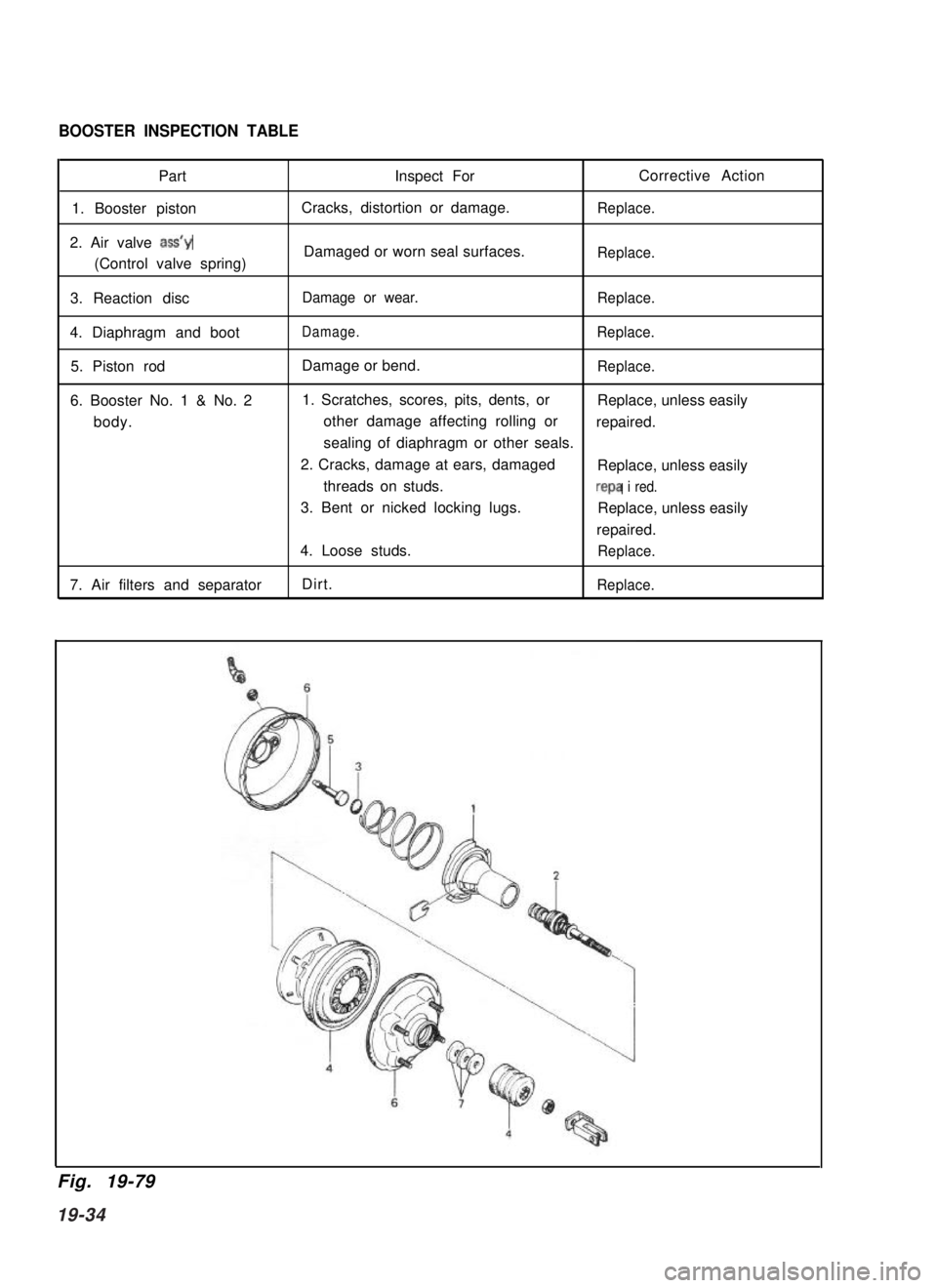
BOOSTER INSPECTION TABLE
Part
1. Booster piston
2. Air valve ass’y
(Control valve spring)
3. Reaction disc
4. Diaphragm and boot
5. Piston rod
6. Booster No. 1 & No. 2
body.
7. Air filters and separator
Inspect ForCorrective Action
Cracks, distortion or damage.Replace.
Damaged or worn seal surfaces.Replace.
Damage or wear.Replace.
Damage.Replace.
Damage or bend.Replace.
1. Scratches, scores, pits, dents, orReplace, unless easily
other damage affecting rolling orrepaired.
sealing of diaphragm or other seals.
2. Cracks, damage at ears, damagedReplace, unless easily
threads on studs.repa i red.
3. Bent or nicked locking lugs.Replace, unless easily
repaired.
4. Loose studs.Replace.
Dirt.Replace.
Fig. 19-79
19-34
Page 420 of 962
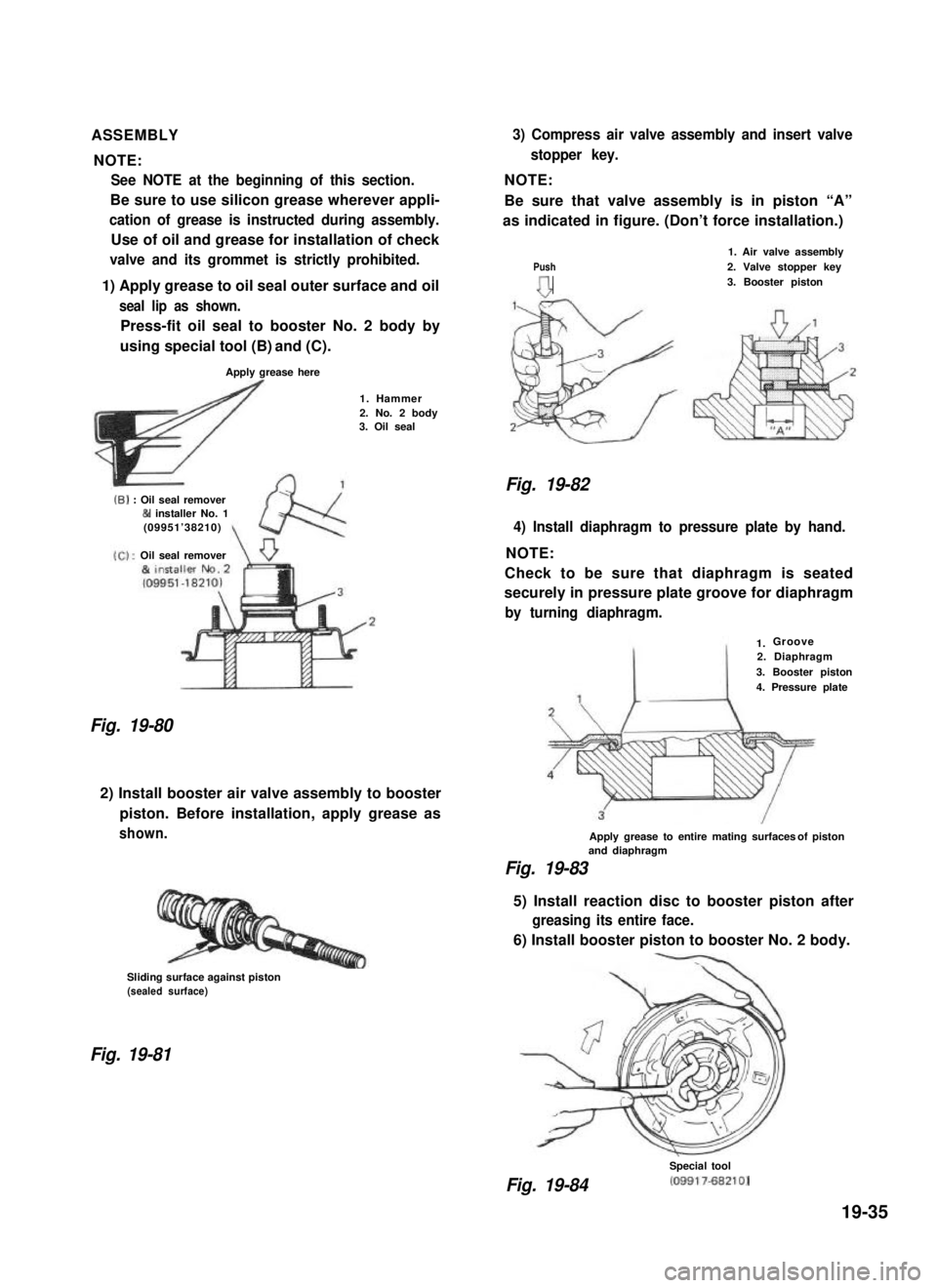
ASSEMBLY
NOTE:
See NOTE at the beginning of this section.
Be sure to use silicon grease wherever appli-
cation of grease is instructed during assembly.
Use of oil and grease for installation of check
valve and its grommet is strictly prohibited.
1) Apply grease to oil seal outer surface and oil
seal lip as shown.
Press-fit oil seal to booster No. 2 body by
using special tool (B) and (C).
Apply grease here
1. Hammer2. No. 2 body3. Oil seal
(6) : Oil seal remover& installer No. 1(09951’38210)
Oil seal remover
Fig. 19-80
2) Install booster air valve assembly to booster
piston. Before installation, apply grease as
shown.
Sliding surface against piston(sealed surface)
Fig. 19-81
3) Compress air valve assembly and insert valve
stopper key.
NOTE:
Be sure that valve assembly is in piston “A”
as indicated in figure. (Don’t force installation.)
Push
n
1. Air valve assembly2. Valve stopper key3. Booster piston
Fig. 19-82
4) Install diaphragm to pressure plate by hand.
NOTE:
Check to be sure that diaphragm is seated
securely in pressure plate groove for diaphragm
by turning diaphragm.
Groove2. Diaphragm
3. Booster piston4. Pressure plate
Apply grease to entire mating surfacesof pistonand diaphragm
Fig. 19-83
5) Install reaction disc to booster piston after
greasing its entire face.
6) Install booster piston to booster No. 2 body.
Fig. 19-84
Special tool
(09917-682101
19-35
1.